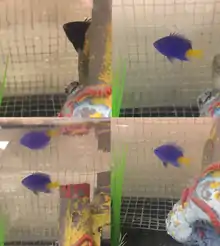Chrysiptera parasema
Chrysiptera parasema, also known as yellowtail damselfish, yellowtail blue damsel, goldtail demoiselle, and other variations, is a popular saltwater aquarium fish from the Indo-Pacific. It was described by Fowler in 1918.[1]
| Chrysiptera parasema | |
|---|---|
 | |
| Scientific classification | |
| Kingdom: | Animalia |
| Phylum: | Chordata |
| Class: | Actinopterygii |
| Family: | Pomacentridae |
| Genus: | Chrysiptera |
| Species: | C. parasema |
| Binomial name | |
| Chrysiptera parasema (Fowler, 1918) | |
| Synonyms | |
|
Abudefduf parasema Fowler, 1918 | |
Appearance
C. parasema is a small marine fish that reaches 2.8-3 inches in length.[1] It has a spiny dorsal fin and is laterally compressed.
Coloring
C. parasema is blue with a distinctive yellow caudal fin (tail fin). The yellow coloring may extend up to the back of the anal and dorsal fins, especially in species from Papua New Guinea. These fish may also have yellow pelvic or pectoral fins. However, yellow is never found on the backs or bellies of Yellowtail Blue damsels. A yellow belly likely indicates that the fish is actually an Azure demoiselle, whereas yellow areas on the nose or chin may indicate that it is a Blue Devil damsel.[1]
Habitat
Yellowtail Blue damsels prefer densely populated coral groupings in sheltered lagoons and inshore reefs, and generally remain between at a depth of between 3–52 feet (1–16 m).[1]
Breeding and reproduction
In the wild, male C. parasema have their own territories, located near a nesting site. Each territory contains eggs from previous females. The females will swim around inspecting each male and its territory before choosing one based on its size and the number of eggs in its territory. As a part of the evaluation, the female will display a light ring around her eyes, and the male will respond with its own displays. The next day, the female will spawn with the chosen male. An individual male can have up to 10,000 eggs from different females. Males often abandon their territories to claim territories with more eggs, as this makes them appear more favorable to the females.[1]
The eggs hatch after up to 4 days, depending on temperature, and the male is responsible for guarding and caring for the eggs. The subsequent larval stage can take 10 to 50 days.[1]

Behavior and diet
Chrysiptera parasema contain chromatophores and can change color in response to external stimuli. When stressed, they can turn darker to conserve energy.[2]
Adults are usually found alone or in pairs, while juveniles are more likely to remain in small groups.[1]
C. parasema are omnivores. In nature, they feed on plankton, algae, and small benthic crustaceans.[1]
In the aquarium
Chrysiptera parasema is a popular fish in the saltwater aquarium hobby. Because of its usually low price it is often recommended as a way for novice marine aquarium keepers to gain experience. Though these hardy fish are sometimes used to cycle a tank, aquariums discourage against this practice, encouraging the use of live rock instead.[3] Thirty gallons is typically quoted as the minimum tank size required to permanently house this fish. In a properly maintained tank, C. parasema will live for 4–6 years or longer, up to 15 years.[1][3]
Behavior
C. parasema prefers peaceful tank mates and abundant hiding spots, as they are frequently preyed upon in nature.[1][4] It is a favorite species among aquarists because it is active, but less aggressive than most damselfish.
However, these fish will sometimes harass more passive fish in an aquarium. In addition, despite its comparatively peaceful nature, this species can be territorial with members of its own species. They tend to become more aggressive when kept singly.[3] This aggression can sometimes be reduced by keeping them in small groups of odd numbered fish (three to seven). They do show schooling behavior when kept in large groups.[5]
Despite its hardy nature, C. parasema also must not be placed in an aquarium with larger predatory fish such as lionfish, and grouper which will often see it as a food source.
Diet
In captivity, C. parasema shows a preference for spirulina, flake foods, and mysis shrimps.[6] However, they tend to go after most fish foods, whether frozen, freeze dried, or live.[3] These fish tend to feed towards the bottom of the tank.[1]
Reproduction
It is very difficult to tell the males apart from the females. In general, males may tend to be larger more slender, and will become more aggressive towards females when they are ready to mate.[4] Males are ultimately responsible for guarding the eggs, so they will also display more territorial behavior over a brood.[6]
Breeding occurs readily in captivity. Females will lay around 300 eggs, which will hatch within 96 hours (a few hours after the lights are turned off). The eggs and larvae, due to their significantly small size, are difficult to rear. In addition, brittle stars, serpent stars, wrasses, and crabs will eat damselfish eggs.[1]
References
- Animal-World. "Yellowtail Blue Damselfish". Animal World. Retrieved 2017-01-24.
- Kasukawa, H.; Oshima, N.; Fujii, R. (1986-01-01). "Control of chromatophore movements in dermal chromatic units of blue damselfish--II. The motile iridophore". Comparative Biochemistry and Physiology. C, Comparative Pharmacology and Toxicology. 83 (1): 1–7. ISSN 0742-8413. PMID 2869880.
- "Yellowtail Blue Damselfish". www.fishlore.com. Retrieved 2017-01-24.
- "Saltwater Aquarium Fish for Marine Reef Aquariums: Yellowtail Damselfish". www.liveaquaria.com. Retrieved 2017-01-24.
- "Archived copy". Archived from the original on 2008-09-06. Retrieved 2010-02-20.CS1 maint: archived copy as title (link)
- "Yellowtail Blue Damsel". SaltwaterFish. Retrieved 2017-01-24.
External links
- Photos of Chrysiptera parasema on Sealife Collection